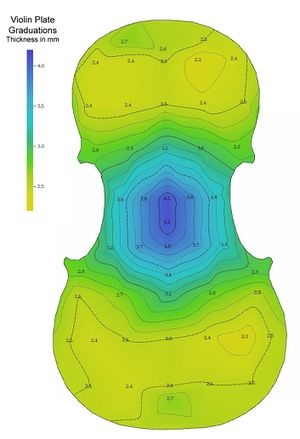Course:PHYS341/Archive/2016wTerm2/HowTheQualityOfTheMaterialAffectsTheQualityOfSound
Musical instruments are made out of various materials for many reasons, ranging from their cost to the properties that certain materials will bring to the sound of the instrument. The sound quality of an instrument is generally dependant on the quality of the craftsmanship and of the materials that it is made of, which in turn will result in a higher priced instrument. However, there are many instruments that, while they are made of very expensive materials, are not necessarily the ones which produce the higher quality sound.
Different Instruments
Brass, gold, maple, oak, etc. all produce different sounds due to their density, stiffness, and overall composition. Brass instruments produce sounds which are louder and more metallic in comparison to the sounds produced by woodwinds which produce sounds of a softer nature. This difference in sound occurs in part because brass has a much higher Q (1000) than maple (100)[1]. This means that it will take approximately 10 more vibration periods to dampen the sound resonating from brass compared to that of maple.
Density and stiffness are two other factors which have a large impact on the way an instrument sounds. The density of a material and the speed at which sound travels through it are negatively correlated, so when the density of a material increases, the speed of sound decreases, as long as everything else remains equal. Sound will travel more slowly when a material is denser because there is a larger number of particles per volume which the sound waves must travel through. On the other hand, when a material increases in stiffness, the speed of sound increases. An increased speed of sound occurs in this case because the stiffer a material is, the more quickly its particles will bounce back to their original position. Brass is both significantly stiffer (approximately 100-125 GPa) and denser (approximately 8,400 kg/m^3) than wood, which can have a stiffness ranging from 6.7 to 13 GPa, and a density of 125 kg/m^3 to 1,325[2]. The effects that the material has on the sound of a musical instrument is why a trumpet made of wood, or a brass violin has never caught on.



Interpreting Figures 2-4
The spike in Fig. 4 indicates that aluminum has the highest speed of sound of the materials compared in these graphs. The significantly faster speed of sound that runs through aluminum is due to its very low density and high stiffness. The woods, maple and oak, do not reach the same high speed because while they are quite close in density to aluminum, they are much less stiff. The opposite is true of gold and silver, where they are similar in stiffness to aluminum, but their very high densities bring their speed of sound way down.
Differences Between Instrument Material
Violins Versus Flutes
The same type of instrument can produce varying qualities of sound depending on the material that it is made of. For example, two violins may be made of the same type of wood, yet produce differing sounds. The grain and age of the wood, as well as the processes which it undergoes (varnishing, glueing, sanding etc.) are some of the factors responsible for these differences. When comparing the sound of two violins, the sound will be more noticeably different than when comparing the sound of two flutes.
An article by Kelly Zappas [3] examined this difference and why flutes do not produce obviously differing sounds, regardless of the properties of the metal that they are made of. There were slight differences in the sounds that were produced with the gold, silver, and platinum flutes, but for the most part, it was concluded that the player of the flute is able to manipulate the sound enough with their embouchure and technique that differences of material quality are hardly noticeable.
Strings
In a separate study [4] it was found that if the strings of an instrument are composed of different metals, then the difference in sound is quite an obvious one. A violinist is not able to manipulate their sound with a mouthpiece in the same way that a flautist can, resulting in less discrete changes to the sound quality. The study found that gold and silver strings, while finer metals, produced a more muted, inharmonic, and louder sound than the strings made of copper, iron, and steel, which is why gold strings of violins are now less popular than steel strings (with the exception of some gold being used to preserve the strings over time).
Body of the Violin

Another reason why the sound quality of a violin changes more than that of a flute has to do with the instrument's soundboard and sound box. Flutes do not have either of these features, so their sound is largely affected by the size of the tube and the spacing of the holes, but most of all, the mouth piece. When the soundboard and back plate of a violin are thinner, the less stiff they become, which will in turn lower the frequency. The sound box is the hollow body of the instrument, and this is what gives the violin and other string instruments a richer sound, as it enhances the lower resonances [5]. Because both the soundboard and the soundbox affect the resonances of the instrument, any differences in their shape or quality would therefore change the way that the instrument sounds.
Cost of Materials
While it is true that the cost of the instrument can be related to the quality of sound that the instrument produces, this does not mean that instruments made of fine materials, like gold or silver, will sound superior to those made simply of aluminum or brass. This is because for many instruments, not only is it impractical and overly expensive for the amount of difference that can be heard, but these materials have been sought out for generations for their specific properties that give them their unique sound. Gold has a density of 19,280 kg/m3 and is over double the weight of the majority of the other metals that instruments are generally made out of, so while a flute made of 24 karat gold would have been highly sought after in centuries past for its extravagance, today our knowledge of physics has advanced enough that we can conclude that silver and aluminum are the better materials when it comes to making flutes. So while silver and aluminum are merely fractions of the price of gold, the properties of gold render it inferior compared to cheaper metals.
See Also
References
- ↑ "Weight Chart for Non-Living Substances," www.mojobob.com/roleplay/weight_chart.html. Accessed March 15 2017.
- ↑ "Weight Chart for Non-Living Substances," www.mojobob.com/roleplay/weight_chart.html. Accessed March 15 2017.
- ↑ Zappas, K. R. (2007). The science of sound: Examining the role of materials in musical instruments. Jom, 59(8), 13-17.
- ↑ Barbieri, P. (2010). Gold and silver-stringed musical instruments: Modern physics vs aristotelianism in the scientific revolution. Journal of the American Musical Instrument Society, 36, 118-154.
- ↑ Chen, M., Kotlicki, A., Waltham, C., Wolfe, N., Yu, J. F., & Zhu, C. (2012). Vibrational behavior of a soundbox in an atmosphere with a variable speed of sound. The Journal of the Acoustical Society of America, 131(3)